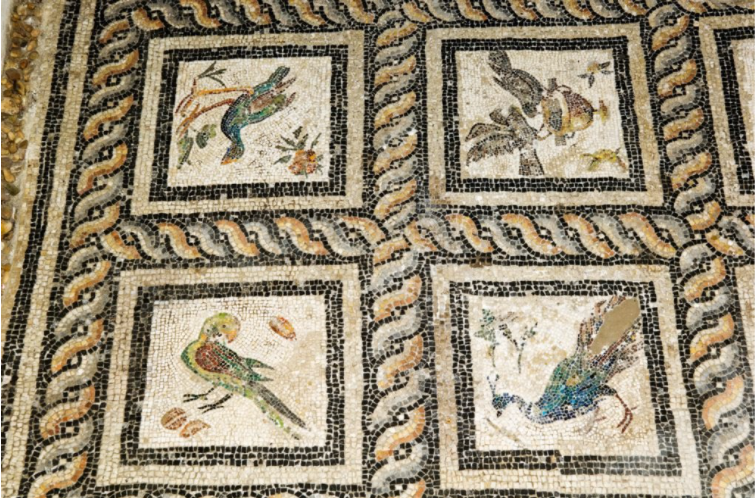Floor mosaic tile showing figures of birds. Mosaic floor in the Villa of the Birds in Alexandria, Egypt.
Why is it called Mosaic Art or Tile Art?
Mosaic is an art form that uses small pieces of material placed together to create a unified whole. Commonly used materials are marble or other stone, glass, ceramics, mirrors, or laminated glass or shells.
The word mosaic comes from Italian mosaic, Latin mosaic, and finally from Greek mosaics, which means to belong to the muse, so it is artistic. Each piece of material is a Tessera (plural: tesserae). There is a gap between the spaces where the grouting is located. The movement and flow of Tesserae are described by the word Andamento. `Opus’, the Latin word `work` means a way of cutting and placing pieces.
The Origins
Mosaic has a long history, beginning in Mesopotamia in the third millennium BC. The pebble mosaics were made in Tiryns, Mycenae, Greece; mosaics with patterns and images became common in the classical era of Ancient Greece and Ancient Rome. Starting in the 4th century, the first Christian cathedrals were decorated with mosaics on the walls and ceiling. Mosaic art flourished in the Byzantine Empire from the 6th to the 15th century; This tradition was adopted in the 12th century by the Norman Kingdom of Sicily, the East-influenced Republic of Venice, and the Russians in Ukraine. Mosaic became obsolete during the Renaissance, although artists such as Raphael continued to practice this ancient technique. Roman and Byzantine influences led Jewish artists to decorate 5th and 6th-century synagogues, in the Middle East, with mosaics on the floor.
The Entry in The Egyptian Culture
After Muslims conquered the eastern provinces of the Byzantine Empire, Islamic architecture used mosaic techniques to decorate religious buildings and palaces. In Syria and Egypt, the Arabs were influenced by the great traditions of Roman and early Christian mosaic art. During the Umayyad Dynasty, mosaic making was still a flourishing art form in Islamic culture. For mosaic art design, Egyptians first used small pieces of glass in mosaics during the New Kingdom period (1550-1069 BC). Very small pieces of opaque stained glass are used to make inlaid jewellery and inlaid gemstones. These stones are added to wall decorations and inlays, usually in funeral art. The Roman Empire did not control Egypt until 31 BC. Glass production in Egypt developed into a higher art form. With abundant sand and soda water, as well as art mastered for many years, Egypt created most of the glass for the Roman nobles.
The Features And Characteristics
Gordium’s black and white pebbles piece together a mosaic of random patterns. The cobblestone mosaic adds art and design to an area and provides some protection in inclement weather. Six centuries later, the mosaic floor is the predecessor of today’s tiled floor, and it is very common among the Greek nobility. Use of smooth river rocks, filling in voids with smaller pebbles and creating more detailed designs to form floors and paths. The introduction of mosaic art further defined the mosaic art, that is, stone and glass shards cut into small squares. These mosaics made of uniform small fragments can easily create complex designs.
Must Read:- Handicrafts In India – A Lost Art





